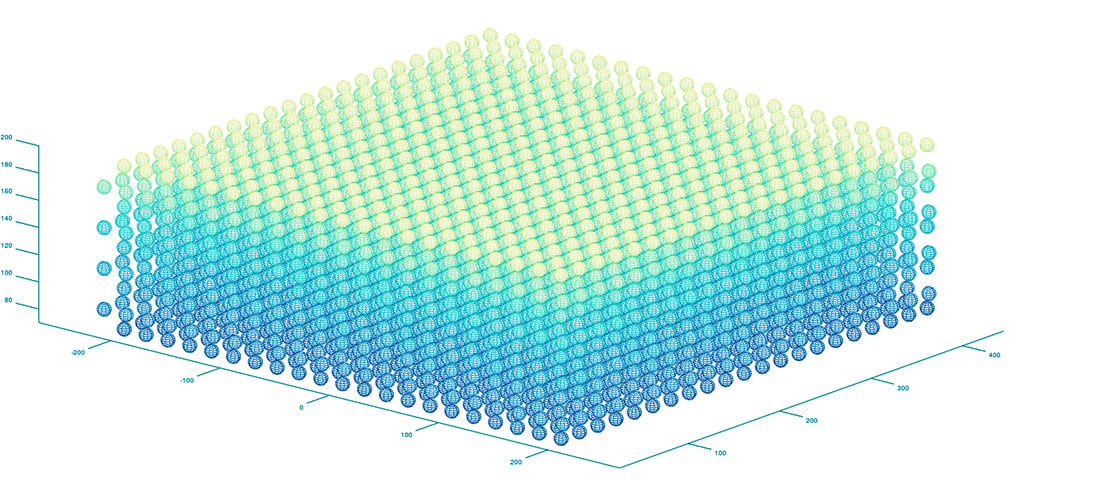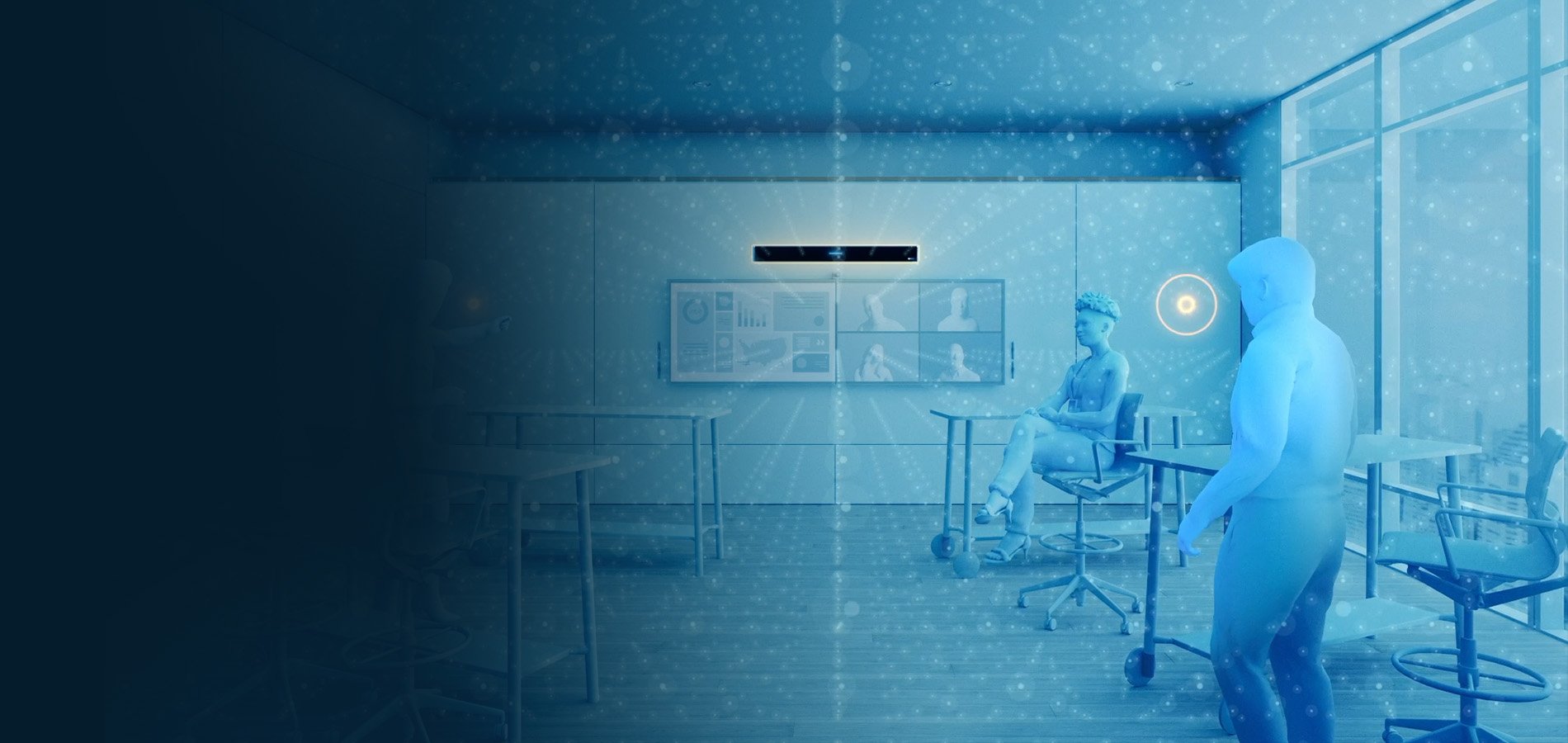Inside our technology
For years, conference call technology was stuck — leaving frustrated users hoping for the kind of breakthrough that has transformed other sectors. Microphone Mist™ technology is that breakthrough.
Patented innovation
With multiple patents from the US and EU patent and trademark offices, Microphone Mist technology is our secret to making mic pickup in larger rooms as easy as it is in smaller rooms. Its precise sound location data enhances camera tracking and automated camera switching. And with a track record of one innovation after another, it’s always getting better.


The virtual mic difference
A virtual microphone is an individual pickup point created when two or more physical microphones work together to focus their sound pickup on a distinct location. Microphone Mist technology listens to each virtual mic simultaneously and zeroes in on the predominant sounds. The result? Natural sounding conversations, even when multiple people talk at the same time.
See how we compare
Microphone Mist technology continuously captures audio in every inch of the room, while beamforming systems can only capture it within active beams.


Unified coverage map
Our patent-pending unified coverage map enables the physical mics from multiple components to be processed together instead of separately, creating a giant microphone array that spans the entire room. Each virtual mic is targeted with greater precision, resulting in clearer, more consistent audio.
Available with HDL410 and HDX

Adaptive Voice Amplification
Amplify a presenter’s or instructor’s voice in the room without diminishing full-room mic pickup for remote participants. Audience mute is included.

Camera integrations
Use precise sound location data with any brand of USB or HDMI camera so remote participants always see who’s speaking.
Resources
Frost & Sullivan report
Learn how simplified large-room audio systems can improve remote collaboration.
Recon Research report
Get an overview of meeting room audio technologies, including our next-gen approach.
AVNetwork roundtable
Hear Duquesne University AV specialists discuss how our technology lives up to its claims.
Video library
Watch product demos, feature highlights, how-to videos, customer stories and more.
Resource library
Find all our product data sheets, brochures, reference designs and reports.

audioXpress article
Acoustic spatial resolution
Discover how virtual mics create higher-resolution audio, and what that means for you.

audioXpress article
Continuous echo cancellation
Explore how our approach to echo cancellation differs from that of beamforming systems.

audioXpress article
Position-based gain control
Find out how our new approach to gain control makes conferencing feel more natural.

audioXpress article
Unified coverage map
Get all the details about our patent-pending feature for extra-large spaces.

Video
The new demands of hybrid work
See how our tech is uniquely suited to solve the challenges of hybrid working and learning.
FAQs
Nureva took an entirely new approach when it created Microphone Mist technology — starting from a “blank sheet of paper” with the goal of finally solving long-standing issues with traditional audio conferencing. Read the full story.
Nureva’s patented Microphone Mist technology fills a room with thousands of virtual microphones. Each virtual microphone is a point in a space where two or more physical microphones work together intelligently to focus on audio pickup. Microphone Mist technology listens to each virtual mic simultaneously and optimizes each one for natural conversations.
Our innovative technology has been granted multiple patents by the United States Patent and Trademark Office and the European Patent Office. They recognize our unique approach to position-based gain control, echo reduction, sound targeting and more. Read about our patents.
By filling spaces with thousands of virtual microphones, our audio systems can provide accurate location data for where people are talking within the room. This sound location data is used to automatically switch between multiple cameras (any USB or HDMI camera works), allowing remote participants to easily follow conversations and see who’s speaking. We also have specific integrations with brands like AVer, Lumens and PTZOptics to enhance camera tracking and switching. Learn more.
Explore our product family
Full-room mic pickup
Our Microphone Mist technology fills spaces with thousands of virtual microphones, so there’s always one nearby. People in the room can be confident they’ll always be heard by those who are remote.
Continuous autocalibration
There’s no need to calibrate your Nureva system manually. It’s always adapting to changes in your room’s acoustic profile, so even if you adjust the furniture or layout, the audio will still sound great.
Intelligent Sound Targeting
HVAC and other unwanted sounds can seriously affect your audio performance. So, instead of trying to suppress these noises after the fact, we use adaptive learning algorithms to preemptively ignore them.
Rapid conversation tracking
Our technology quickly identifies where a person is speaking and targets that spot. Conversations sound natural, even when multiple people are speaking at the same time.
Position-based gain control
We apply gain separately to each sound in a space based on its position, creating a smooth and natural listening experience for remote participants.
Virtual microphones: Real. Different.
With multiple patents, Microphone Mist technology is truly a revolutionary advancement in audio conferencing. At its heart is the very real concept of virtual microphones. A virtual microphone is an individual audio pickup point created when two or more physical microphones work together to focus their pickup patterns on a specific location. Each virtual mic behaves similarly to an omnidirectional microphone being placed at that point in the room. Our audio systems fill rooms with thousands of virtual microphones so voices are picked up everywhere.
The virtual mic advantage
Nureva® audio systems use position-based gain control to make specific optimizations to the microphone system and processing of all the sound sources in the room. These patented processes enable Nureva to optimize the talker’s gain while keeping ambient noise quieter and more constant. No matter where a person moves in the room, a virtual microphone is always nearby — and no detectable transition occurs as the talker moves between virtual mics as one might experience when moving between beams in a beamforming system.

Pickup resolution matters
Traditional microphone technologies — such as beamforming — subdivide the room into large zones (as many zones as there are microphones). If there are, for example, three zones in a beamforming array, you get low spatial resolution information. Although the coverage zones are large, traditional systems are not able to discriminate between the individual sound sources within a single zone. This means diminished ability to optimize individual sound sources in a zone for the appropriate gain setting, noise filtering and overall audio signal.
Microphone Mist technology fills a room with thousands of virtual microphones, subdividing the room into thousands of spatial bubbles for a higher spatial resolution of audio signals. This allows the system to isolate and zoom in on individual talkers, providing more audio information that in turn allows it to optimize both acoustic microphone pickup performance and post-processing of the audio signal.















